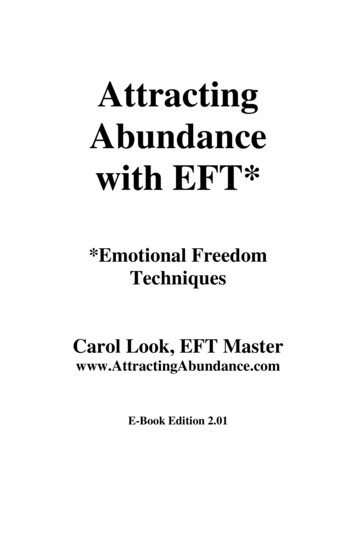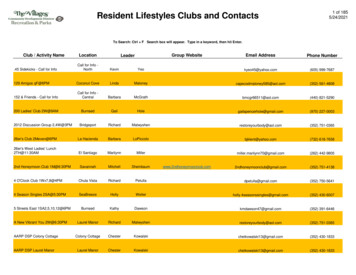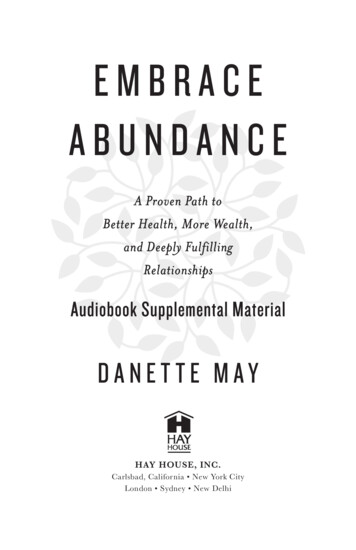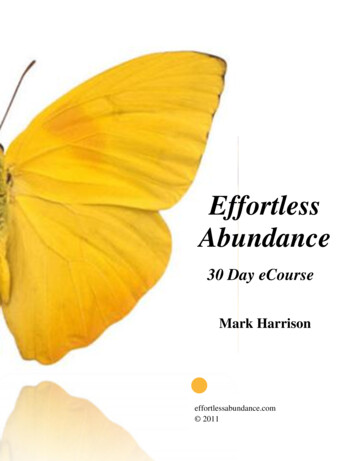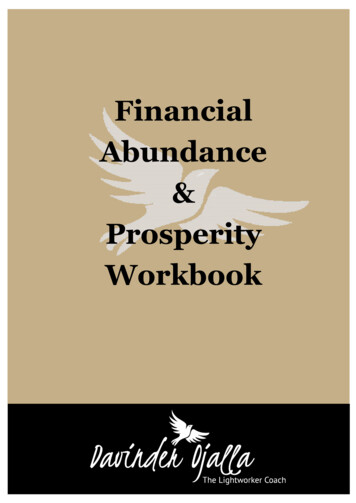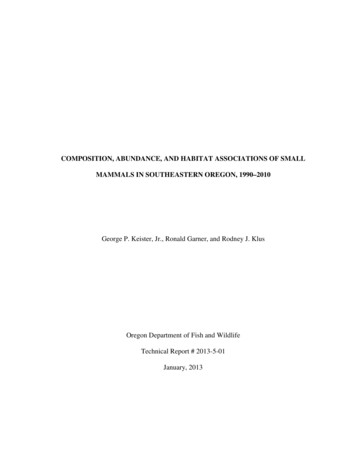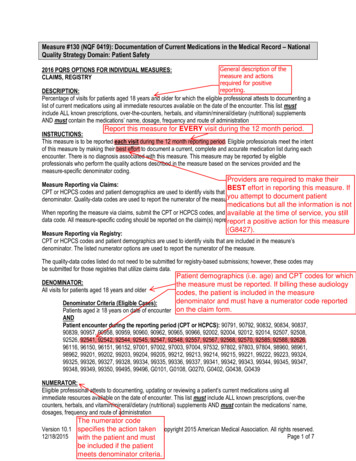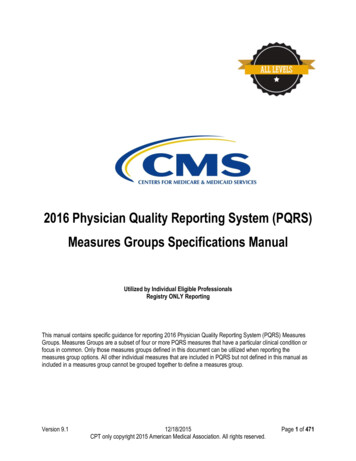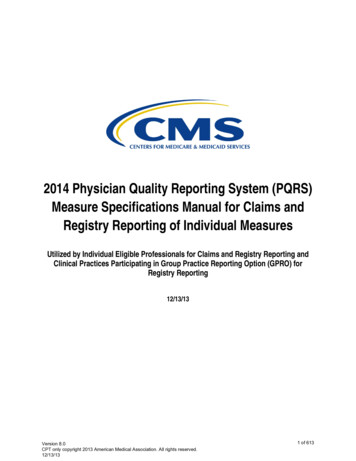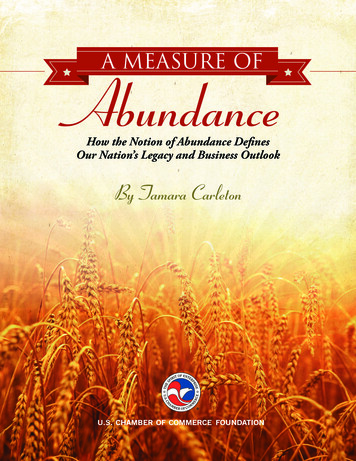
Transcription
A MEASURE OFAbundanceHow the Notion of Abundance DefinesOur Nation’s Legacy and Business OutlookBy Tamara Carleton
AbundanceA MEASURE OFThe U.S. Chamber of Commerce Foundation (USCCF) is a 501(c)(3) nonprofit affiliate of the U.S.Chamber of Commerce dedicated to strengthening America’s long-term competitiveness by addressingdevelopments that affect our nation, our economy, and the global business environment.The views expressed herein are those of the author and do not necessarily state or reflect those of the U.S. Chamber of Commerce Foundation, the U.S. Chamber ofCommerce, or its affiliates.Copyright 2013 by the United States Chamber of Commerce Foundation. All rights reserved. No part of this publication may be reproduced or transmitted in any form—print, electronic, or otherwise—without the express written permission of the publisher.Page 2
A MEASURE OFAbundanceAs the world becomes increasingly more complexand connected, American leaders and businesseshave a unique advantage. Unlike our global counterparts,we are pioneering a path of abundance. Beyond increasedtechnology—which holds the ability to radically transformlives and marketplaces—abundance is also embodied in apositive mindset and in available talent, resources, and knowhow integral to the American character. What does abundancemean for our nation’s future, and what levers can be used toshape abundant outcomes in healthy and rewarding ways?Page 1
AbundanceA MEASURE OFA Definition of AbundanceAs Americans, we are enchanted with the idea of abundance. We like to strive for big goals,live expansively, and demand more results. Even foreigners often brand Americans in termsof abundance, stereotyping our country as filled with bighearted and overly optimisticpeople who are generous with foreign aid, hefty portions, and an excess of material possessions.The truth is more complicated.A casual survey of my colleagues and other industry experts about what abundance entails showsmultiple aspects of American abundance in practice. These aspects are a mix of soft factors (e.g.,people, prosperity, and attitude) and hard factors (e.g., technology and resources), as well as thoserelated to finance (e.g., money and affluence) and governance (laws).TecheuencsceLaws Millionaires Home ownershipAttituderou Taxes Regulations Legal rulingsIDEALABUNDANCECITYesR National debtMoney Venture funds Offshore funds Small business loans Gross domestic product Middle class incomes Consumer spendingAfflelopPe Minority groups Retirees Entrepreneurs ImmigrantsProsperityFor some, abundance indicates affluence, reflected in statistics of homeownership andhomegrown millionaires. For others, abundance can be found in our nation’s raw resourcesand agricultural bounty. Those critical of abundance see overload in terms of money and legalrequirements, such as a growing national debt and an increasing number of business regulations.These aspects are all significant examples of modern abundance, and the exact mix will changebased on whom you ask. American optimism Sense of financialsecurity Natural gas Corn Domestic oil Foreign oil Device ownership Patent applicationsFigure 1: Multiple aspects exist in the notion of abundance.What holds constant is simply the belief in more. As a belief, abundance drives our faith andintentions around growth—at home, in business, and in politics. We believe that more is a goodthing, and that achieving more in life and work is important for our personal satisfaction and toour national identity.Page 2
Captured in the American DreamWe can trace our unique romance with abundance to the American Dream. TheAmerican Dream is a vision of a grand land in which “life should be better andricher and fuller for everyone,” as James Truslow Adams wrote in his 1931 bookThe Epic of America. Rooted in our Declaration of Independence, which proclaims “all men arecreated equal,” the American Dream has come to symbolize an enduring set of ideals of freedom,equality, and opportunity. Anyone can achieve prosperity through hard work, and despitebackground or upbringing, everyone has the equal opportunity for success in this country.Immigrants around the world have been drawn to the power of the American Dream, arrivingwith little more than their hopes to start anew and succeed. They often saw a democratic land ofimmense possibility that created men and women who were rugged, enterprising,and productive.Captured in writing, the American Dream has been a recurring theme for many American writersfrom Mark Twain to Langston Hughes. “America is another name for opportunity” is a popularquote often attributed to essayist Ralph Waldo Emerson. More than a chance for materialisticadvancement, the United States offered a social and moral opportunity to develop free men intheir intelligence and character during our country’s formative years.Since then, the vision of the American Dream has grown slightly and now includes a beliefin owning a home. A higher percentage of Americans own a home compared with otherindustrialized nations, partly because it has become an unquestioned national norm and partlybecause houses have become smart investment vehicles.New York Times journalist Anthony DePalma observed a decade ago that “houses have becomenot so much good places to raise families—although that still is important—as the bases fromwhich to raise fortunes.”The American Dream has come to symbolize anenduring set of ideals of freedom, equality, and opportunity.Page 3
AbundanceA MEASURE OFSome Historical MeasuresAquick look across America’s history shows other measures of abundance that haveinfluenced views and expectations. Colonists in the 17th century considered abundancein the context of land rights. Legal property grants to new settlers helped encourageimmigration to the colonies, and the more land a person had, the greater chance for financialsecurity and a higher quality of life in the new country.By the 18th century, American citizens embraced a profusion of freedoms that became embodiedin the Declaration of Independence, the U.S. Constitution, and the Bill of Rights. These threenational documents characterized abundance as a strong declaration of basic human rights.In the mid-19th and early 20th centuries, several gold rushes—especially the California GoldRush of 1848—offered the promise of instant wealth and captured the imagination of the nation.Beyond the miners profiting, the gold rushes also spurred a rise of migration, trade, colonization,and new business economies. These gold rushes were emblematic of a larger outlook of abundancethat can be seen in the pursuit of the American frontier and the Manifest Destiny doctrine.By the late 19th century, a rising class of nouveau riche in the United States had acquired theirwealth on their own terms in lieu of family inheritance. Famous industrialists such as John D.Rockefeller and Andrew Carnegie took advantage of the growing industries in mining, oil, steel,and trains and then shared their hard-earned fortunes with other Americans through generousphilanthropy efforts.As the United States shifted from an agricultural to a more industrialized economy afterWorld War II, Americans required different skills. The G.I. Bill of 1944 drove enrollment inhigher education and other forms of training. Subsequently, the U.S. Census included a newquestion about people’s educational attainment in 1947, reflecting a new national awareness anda rise in college degrees.The decade after World War II has been called the Golden Age of Capitalism. It was a periodof economic prosperity, leading to a concurrent boom in population. While other parts ofthe world struggled to rebuild from the devastation of World War II, American citizens sawtheir standard of living surpass what previous generations had only dreamed about. With therise of suburbia, an astounding number of American households spent their money on cars,televisions, and other modern appliances. The first credit cards were introduced, enabling peopleto buy more consumer goods based on future expectations of cash. Two beliefs of abundancewere intertwined: Americans believed that they needed to enjoy life more and that they wouldcontinue earning more money to afford that lifestyle.Page 4
)us s,sel enhem ssna t (cicotrohh eihmat en rs, ancauusrigorcedu m Ca plivdnd 0ssee 0s ol 0s ou 0s Ed tainarap 950L 60G 85t 47F 76N 90a1111119dsogoerymxuouclsinas 0s et 0sM 99 N 0121MassSocietalprosperity evolution20082011TechnoEntrepreneurs optimism20122012Figure 2: Various historical measures of abundance can be seen across American history.A strong consumer culture grew, and luxury goods gradually became diffused into the masses.By the 1990s, a state of affluence was reflected throughout middle class ranks—conspicuouslymarked by BMW cars, Louis Vuitton handbags, and Rolex watches, among other status symbols.Most recently, the federal government has questioned and measured American abundance interms of net income and what that means for tax responsibility.Reflecting the zeitgeist of recent years, several books about abundance have been published inquick succession. In The Age of Abundance (HarperBusiness, 2008), Brink Lindsey from theKauffman Foundation discusses the nation’s economic expansion post-World War II, whichhelped shape a sense that anything was possible. It is now seen in the profuse enthusiasm of theMillennials generation. Science writer Matt Ridley expects that human nature will always prosperdue to the cumulative power of ideas in The Rational Optimist (Harper Perennial, 2011).Philip Auerswald, a public policy professor and senior fellow at the Kauffman Foundation,argues in The Coming Prosperity (2012, Oxford University Press) that people are the solution—particularly entrepreneurs who will be instrumental in seizing opportunities arising in emergingeconomies. Entrepreneur and X-Prize founder Peter Diamandis and writer Steven Kotler take atechno-optimistic stance in their book Abundance (Free Press, 2012), positing that technologywill deliver a better future across the world.Page 5
AbundanceA MEASURE OFThree Big Levers for GrowthDrawing from this legacy and with an inherent outlook of abundance, the United States canrely on three primary levers—talent, capital, and markets—to further boost our nation’sleadership position in the ensuing decades.The first lever is talent. The United States is the third most populous country after China and India.Even as our birth rates slow, we will add 35 million working-age people by 2050, while Europe willlose 37 million and China will shrink by 100 million. By having a greater number of skilled peoplethan other countries, as well as fostering pro-immigration policies, our nation will be able to domore, trade more, and affect more globally.This abundance in talent is changing the world of education. The traditional model of educationis defined by closed enrollment, is based on classroom learning, and is institutionally driven.The new model has opened access, is based on mobile learning, and is community driven. Now,anyone can teach and learn through an array of channels, such as online course provider Udemyand programs that are increasingly self-defined and socially linked. For example, Nota Reader istransforming the classic textbook into an open collaborative learning experience that is furtherconnected across tablets and laptops.The second lever is capital. Nonfinancial U.S. companies held a record-breaking 1.24 trillion incash as of December 2011, up 3% from 2010, according to Moody’s Investors Service, which isavailable to fund new research and other development activities. Moreover, nearly 119 billion inventure funds sit as “dry powder” to fund new companies, all of which help grow the Americaneconomy and provide more business opportunities.This abundance of funds is changing the private capital industry. In corporations, the traditionaltechnology innovation model follows a stage-gate process—the industry standard for managingnew product development as a series of internal process stages with decision “gates”—that oftenthwarts radical ideas and rejects possible external solutions. Outside of big companies, entrepreneurstypically turn to venture capitalists for high-growth funding.A new model of capital has emerged that thrives on rapid prototyping and crowdfundingmechanisms. Not only can anyone be a creator or inventor, he or she can more easily find potentialfunders and customers through a set of new services that never existed a decade ago. Considercrowdfunding platform Kickstarter, which allows individuals to sell the potential for a newcreative idea to the mass market. By aggregating previously distributed and untapped demand tosell forward, Kickstarter increases our nation’s appetite for abundance.Page 6
Another aspect of abundance is that we are producing more goods and services today due to loweroperating costs. Businesses can now start up and operate entirely online, costing a fraction of whatit did in years past.Moreover, funding is available at all levels of investment through multiple channels, which has beenexpedited by the Jumpstart Our Business Startups (JOBS) Act of 2012. This is another big changein capital. President Obama has declared that startups and small businesses will “now have access toa big new pool of American investors—namely, the American people.”The third lever is markets, specifically an ability combined with the know-how to create newmarkets and quickly dominate emerging markets. Many American companies harness globaleconomies of scale that yield tremendous returns on investment for the American economy.For example, in the telecom industry in 2005, the top mobile manufacturers were Swedish,Japanese, and Finnish. Today, American technology company Apple dominates the telecomindustry, jumping from 20th to 7th place in CNNMoney’s last annual ranking of the mostprofitable companies in the world. This occurred largely as a result of its strategic partnership withChinese manufacturer Foxconn. Apple has further announced it will bring manufacturing jobs backto the United States with the support of Foxconn.This abundance of markets is changing the usual process of new product development. Thetraditional model has been to start domestically and work with regionally tied supply chains.Companies now start with a global mindset and expect a network of international operations.Even the average person can undertake product design and manufacturing instantly at a reasonablecost. A growing Maker Movement celebrates a do-it-yourself mentality as people create their owntechnology gadgets and other engineering projects. For instance, a recent pop-up store called 3DEAintroduced the holiday shopper to personal 3D printing and design in New York City’s fashiondistrict. These types of experiments are creating more opportunities and niche markets that enableAmerican ingenuity to flourish.Businesses can now start up and operate entirely online,costing a fraction of what it did in years past.Page 7
AbundanceA MEASURE OFTable 1: How the three levers of talent, capital, and markets are transforming multiple LEMERGINGMODELSOMEIMPLICATIONSEducation Closedenrollment Classroom based Institutionallydriven Open access Mobile based Communitydriven Anyone can teach More learningoptions/channels Variety of selfdefined programsPrivatecapital Slow stage gates Not inventedhere Venture funding Rapidprototyping Inventedeverywhere Microfunding More ideas Faster failurecycles Greater accessto buyers andfundersNewproductdevelopment Domestic start Regionally tiedsupply chains Global start Globallydistributed Anyone candesign and ship Movingmanufacturingback to U.S.TALENTCAPITALMARKETSPage 8
Why Abundance MattersAmerican business and community leaders are on a path of abundance. Abundancematters to business because it is a belief system that shapes intentions and expectationsin the marketplace and beyond. Most important, people are what they believe they are.The concept of abundance brings positive connotations, yet some worry that we can have toomuch of a good thing. Can the pursuit of abundance lead to arrogance or greediness? As withmost things, excess can be harmful.The key point is to know when to consider abundance as a state of fullness or overflowing, ratherthan as a quantity or surplus amount. For instance, it is the difference between a company’ssuccess being measured by the stronger brand position it has gained versus the amount ofproducts it has sold. Depending on the context, abundance as a state of fullness may be a moreuseful and revealing indicator than a quantity one.Fundamentally, the notion of abundance is embedded into the American ethos. Henry Miller, anAmerican writer and painter wrote in 1957: “Like it or not, I am a product of this land of plenty,a believer in superabundance, a believer in miracles.”His observation remains true today. Americans value abundance, and now is the time forindustry to take up this mantle. As we emerge from a shell-shocked economy, business leaders,entrepreneurs, and innovators must dream big again, building the next era of the American Dream.We believe that more is a good thing, and thatachieving more in life and work is important for ourpersonal satisfaction and to our national identity.–Tamara CarletonPage 9
AbundanceA MEASURE OFAbout the AuthorTAMARA CARLETONFounder and Chief Executive, InnovationLeadership Board LLCTamara Carleton, Ph.D., is founder and chief executive ofInnovation Leadership Board LLC, a global leader in thedesign of tools and processes that enable radical innovation.Client organizations included Deutsche Bank, Microsoft, Samsung, SAP, Tekes, and Volvo.Carleton serves as a fellow at the U.S. Chamber of Commerce Foundation, exploring howemerging technologies and resources have created an unprecedented state of abundance forindividual well-being and job creation. Previously, she was a fellow with the Foundation forEnterprise Development and a fellow for the Bay Area Science and Innovation Consortium.In addition, Carleton teaches organizational innovation and foresight strategy in StanfordUniversity’s School of Engineering executive education program. Drawing on her businessexperience, Carleton’s research agenda focuses on industry innovation, particularly issuesrelated to technical visionary leadership, innovation culture, regional innovation, andforesight strategy. This work builds on her pioneering study of the innovation practices of theU.S. Defense Advanced Research Projects Agency (DARPA).A former management consultant at Deloitte Consulting LLP, Carleton specialized inemerging solutions in enterprise applications, customer experience, and marketing strategy.At Deloitte, she developed two proprietary methodologies, the Customer Experience Auditand Persona Design, which were incorporated into client service offerings.Carleton holds a doctorate in mechanical engineering from Stanford University, amaster’s of science in public relations from Syracuse University, and a bachelor’s degreein communication from The George Washington University. She has been published in avariety of technical journals, as well as the general business press. Most recently, Carletonedited the book Sustaining Innovation: Collaboration Models for a Complex World (Springer,2011), which explores emerging institutional models of sustainable innovation from multipleinternational viewpoints. She is frequently invited to discuss her work and research in theUnited States and abroad.Page 10
Abundance Reading ListAuerswald, Philip. (2012). The Coming Prosperity: How Entrepreneurs Are Transforming theGlobal Economy. Oxford University Press.Through the power of social networking tools and online services, more people are being connectedto the global economy, and a rise of entrepreneurs in the developing world will take the lead in addressing the world’s problems, argues Auerswald, a public policy professor and Kauffman Foundationfellow.Covey, Stephen R. (1989). The 7 Habits of Highly Effective People: Powerful Lessons in PersonalChange. Free Press.In this bestselling book, Covey posits how an “abundance mentality,” which occurs when a personbelieves there are enough resources and success to share with others, leads to win-win situations andgreater personal success.Diamandis, Peter, and Kotler, Steven. (2012). Abundance: The Future Is Better Than You Think.Free Press.Entrepreneur and X-Prize founder Diamandis teams up with writer Kotler to take a techno-optimistic stance, positing that the mix of new technologies, its inventors, and funders will deliver a betterfuture across the world, reaching even the poorest people.Lindsey, Brink. (2008). The Age of Abundance: How Prosperity Transformed America’s Politicsand Culture. HarperCollins.Brink, a senior scholar at the Kauffman Foundation, argues that the widespread affluence and consumer materialism post-WWII was good for American society and economics.Potter, David M. (1954). People of Plenty: Economic Abundance and the American Character.University of Chicago Press.Over 50 years ago, historian Potter delved into the unique national character of the United States. Hebelieved that abundance is central to the American spirit, and in particular, Americans like to perceiveabundance as freedom of choice.Ridley, Matt. (2011). The Rational Optimist: How Prosperity Evolves. HarperCollins.Science writer Ridley tells us that life continues to improve at an accelerating rate. He expects humanity will always prosper due to the cumulative power of ideas.Page 11
AbundanceA MEASURE OFNotesPage 12
Page 13
1615 H Street, NW Washington, DC 20062-2000www.uschamber.com
Those critical of abundance see overload in terms of money and legal requirements, such as a growing national debt and an increasing number of business regulations. These aspects are all significant examples of modern abundance, and the exact mix will change based on whom you ask. Figure 1: Multiple a
